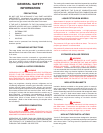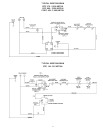
12
3. The correct test instruments are:
•CO
2
indicator or 0
2
analyzer
• CO indicator
• Stack thermometer
• Draft gauge or inclined manometer
• U-tube manometer or calibrated 0-10” and 0-35” w.c.
pressure gauge
• Combination volt/ammeter.
Suggested safety device test procedures are:
A. While heater is operating, turn valve, main burner and pilot
gas line manual gas cocks to the OFF position. Burner should
shutdown within 3-4 seconds and lockout on flame failure,
requiring reset of the flame safeguard device.
B. While heater is operating, lower the setting of each of (2)
operating thermostats (one at a time). During this setting
change, the burner should shutdown when the called for
temperature is less than the temperature indicated on the
thermometer. Restore the settings to original values and burner
should restart.
Should any of the above operating test fail, replace the involved
component.
MAINTENANCE
GENERAL
Water heater maintenance includes periodic tank flushing and
cleaning, and removal of lime scale. The power burner should
be inspected and adjusted to maintain proper combustion. Refer
to the following table. A periodic inspection of the venting system
should be made. Where used, the water heating system
circulating pump should be oiled.
KEEP APPLIANCE AREA CLEAR AND FREE FROM
COMBUSTIBLE MATERIALS, GASOLINE AND OTHER
FLAMMABLE VAPORS AND LIQUIDS.
FLUSHING
1. Turn off the heater electrical disconnect switch.
• For convenience, the switch on the outside of the control
compartment can be used.
2. Open the drain valve and allow water to flow until it runs clean.
3. Close the drain valve when finished flushing.
4. Turn on the heater electrical disconnect switch.
MAINTENANCE SCHEDULE
Component Operation Interval Required
Flushing Monthly
Sediment
Tank Removal Semi-Annually
Lime Scale UN•LIME
®
Removal As Required Delimer
Relief Valve Inspect Semi-Annually
Power Burner SAE No. 20
Motor(1) Inspect Quarterly non-detergent
motor oil
Power Burner Combustion
and Ignition Inspection Semi-Annually test kit &
Device(2) test
specifications
Main Burner Check Flame Annually
Flue Baffle
Pipe(3) Cleaning As Required Wire Brush
Vent System
and Barometric Inspect Semi-Annually Draft Gauge
Damper
(1) If furnished with oiling provisions
(2) If flange gasket is damaged, it must be repaired.
(3) COF and COBT Only.
DRAINING
The heater must be drained if it is to be shut down or exposed to
freezing temperatures. Maintenance and service procedures may
also require draining the heater.
1. Tun off the heater electrical disconnect switch.
2. Close the cold water inlet valve to heater.
3. Open a nearby hot water faucet to vent the system.
4. Open the heater drain valve.
5. If the heater is being drained for an extended shutdown, it is
suggested the drain valve be left open during this period.
• Follow FILLING instructions when restoring hot water service
SEDIMENT REMOVAL
Waterborne impurities consist of fine particles of soil and sand
which settle out and form a layer of sediment on the bottom of the
tank.
For convenience, sediment removal and lime scale removal
should be performed at the same time.
LIME SCALE REMOVAL
The amount of calcium (lime) released from water is indirect
proportion to water temperature and usage. The higher the water
temperature or water usage, the more lime deposits are dropped
out of the water. This is the lime scale which forms in pipes, heaters
and on cooking utensils.


















